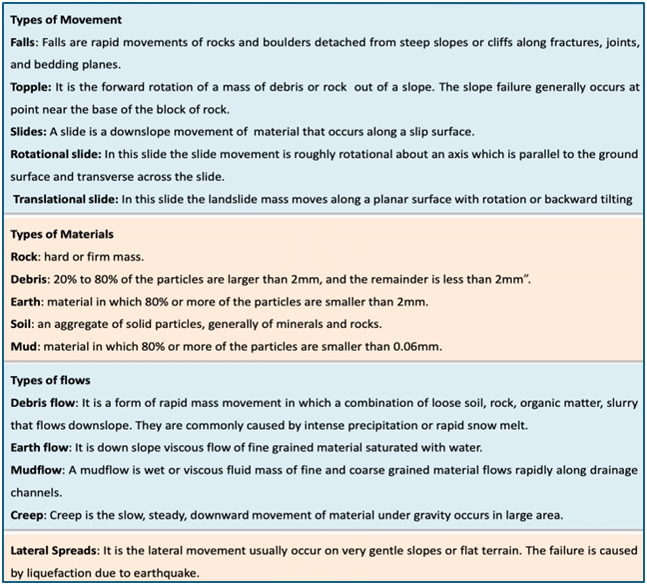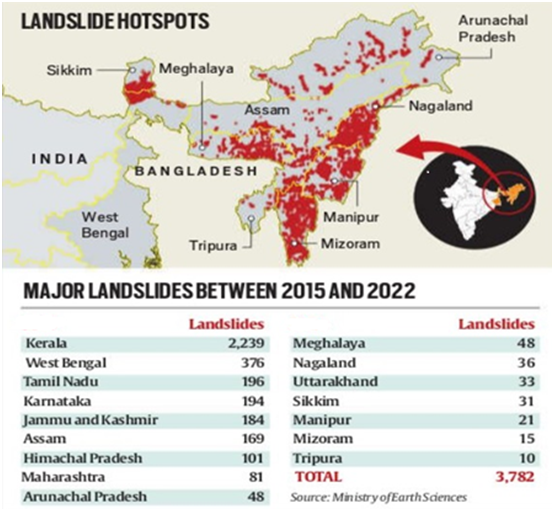Why in news?
Six people were killed in West Bengal in incidents triggered by cyclone Remal that struck the coastline recently. In Northeast, heavy rain caused by the cyclone triggered landslides in several places in Meghalaya, Mizoram, Assam, and Nagaland, which have resulted in the deaths of at least 30 people so far.
Almost the entire region, including Sikkim and northern West Bengal, is landslide prone. Cyclone-triggered landslides have hit Northeastern states on earlier occasions as well. Cyclone Aila had caused landslide events in this region in May 2009.
What’s in today’s article?
- Landslides and factors responsible
- Classification and mapping of landslides
- Landslide vulnerability of India
- Steps taken by India to deal with landslides
- Way forward
Landslide and factors responsible
- A landslide is defined as the movement of a mass of rock, debris, or earth down a slope.
- Landslides are a type of "mass wasting," which denotes any down-slope movement of soil and rock under the direct influence of gravity.
- Landslides occur mainly in mountainous terrains where there are conducive conditions of soil, rock, geology and slope.
- Natural Causes that trigger includeS heavy rainfall, earthquakes, snow melting and undercutting of slopes due to flooding.
- Landslides can also be caused by Anthropogenic Activities such as excavation, cutting of hills and trees, excessive infrastructure development, and overgrazing by cattle.
- In India, rainfall-induced landslide events are more common.
Classification and mapping oflandslides
- Landslides are broadly classified based on the –

Landslide vulnerability of India
- According to the Geological Survey of India (GSI), about 42 million square km of India’s landmass, or about 13% of its area, spread over 15 states and 4 UTs is prone.
- This covers almost all the hilly regions in the country. About 0.18 million square km, or 42% of this vulnerable area is in the Northeastern region, where the terrain is mostly hilly.

Steps taken by India to deal with landslides
- NDMA is working with GSI
- The National Disaster Management Authority (NDMA) has been working with GSI and other agencies to mitigate and manage the risks from landslides.
- National Landslide Risk Management Strategy finalized
- A National Landslide Risk Management Strategy was finalised in 2019.
- This strategy talked about vulnerability mapping, identifying the most vulnerable locations, development of an early warning system, and preparation of mountain zone regulations.
- Early warning
- Some early warning systems have been developed and deployed on a trial basis at a few locations. These warning systems are linked to rainfall forecasts from IMD.
- The rainfall prediction is combined with soil and terrain information to calculate whether it is likely to result in displacement of land.
- Since earthquakes themselves cannot be predicted, building landslide early warning based on earthquakes can be difficult.
- But rainfall-based early warning systems for landslides seem to work well.
Way forward
- Need to factor in the carrying capacity of mountains
- The risk from landslides has been exacerbated by the failure to remain mindful of the terrain’s ability to withstand the load.
- Many hilly areas do not have building regulations. Often, regulations are not implemented effectively.
- New constructions, infrastructure development, and even agricultural practices can increase the risk of landslides.
- Need for building resilience to multi-hazard disasters
- One event can trigger another, and can lead to multiple disasters simultaneously.
- Over the last few years, India has witnessed events in which heavy rainfall has resulted in a breach of glacial lakes, causing flash floods that have resulted in landslides and flooding.











